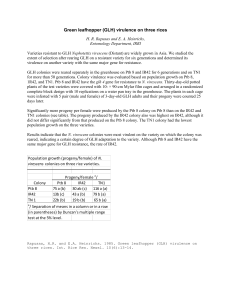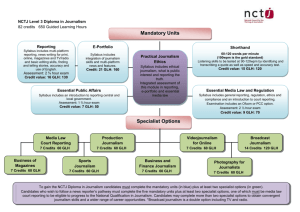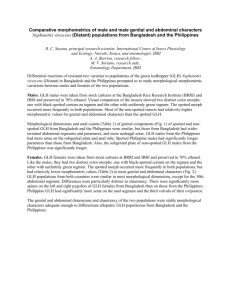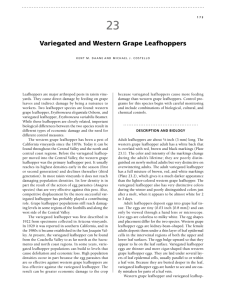Dispersal pattern of Nephotettix virescens
advertisement
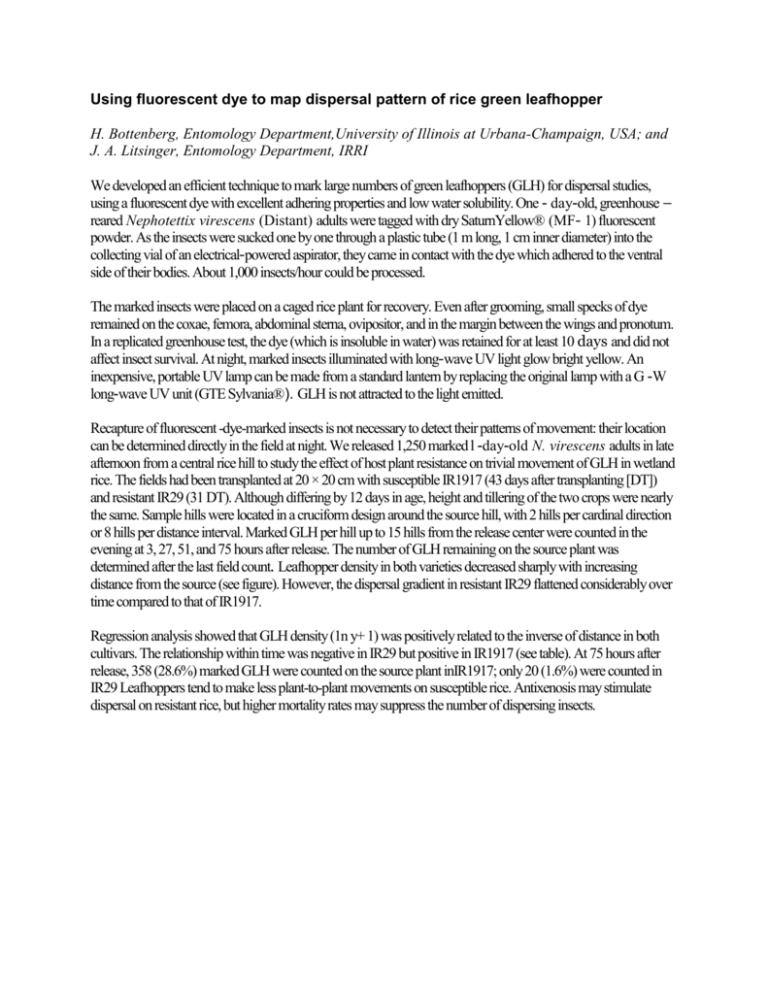
Using fluorescent dye to map dispersal pattern of rice green leafhopper H. Bottenberg, Entomology Department,University of Illinois at Urbana-Champaign, USA; and J. A. Litsinger, Entomology Department, IRRI We developed an efficient technique to mark large numbers of green leafhoppers (GLH) for dispersal studies, using a fluorescent dye with excellent adhering properties and low water solubility. One - day-old, greenhouse – reared Nephotettix virescens (Distant) adults were tagged with dry SaturnYellow® (MF- 1) fluorescent powder. As the insects were sucked one by one through a plastic tube (1 m long, 1 cm inner diameter) into the collecting vial of an electrical-powered aspirator, they came in contact with the dye which adhered to the ventral side of their bodies. About 1,000 insects/hour could be processed. The marked insects were placed on a caged rice plant for recovery. Even after grooming, small specks of dye remained on the coxae, femora, abdominal sterna, ovipositor, and in the margin between the wings and pronotum. In a replicated greenhouse test, the dye (which is insoluble in water) was retained for at least 10 days and did not affect insect survival. At night, marked insects illuminated with long-wave UV light glow bright yellow. An inexpensive, portable UV lamp can be made from a standard lantern by replacing the original lamp with a G -W long-wave UV unit (GTE Sylvania®). GLH is not attracted to the light emitted. Recapture of fluorescent -dye-marked insects is not necessary to detect their patterns of movement: their location can be determined directly in the field at night. We released 1,250 marked l -day-old N. virescens adults in late afternoon from a central rice hill to study the effect of host plant resistance on trivial movement of GLH in wetland rice. The fields had been transplanted at 20 × 20 cm with susceptible IR1917 (43 days after transplanting [DT]) and resistant IR29 (31 DT). Although differing by 12 days in age, height and tillering of the two crops were nearly the same. Sample hills were located in a cruciform design around the source hill, with 2 hills per cardinal direction or 8 hills per distance interval. Marked GLH per hill up to 15 hills from the release center were counted in the evening at 3, 27, 51, and 75 hours after release. The number of GLH remaining on the source plant was determined after the last field count. Leafhopper density in both varieties decreased sharply with increasing distance from the source (see figure). However, the dispersal gradient in resistant IR29 flattened considerably over time compared to that of IR1917. Regression analysis showed that GLH density (1n y+ 1) was positively related to the inverse of distance in both cultivars. The relationship within time was negative in IR29 but positive in IR1917 (see table). At 75 hours after release, 358 (28.6%) marked GLH were counted on the source plant inIR1917; only 20 (1.6%) were counted in IR29 Leafhoppers tend to make less plant-to-plant movements on susceptible rice. Antixenosis may stimulate dispersal on resistant rice, but higher mortality rates may suppress the number of dispersing insects. Figure. Dispersal gradients of marked green leafhopper N. virescens at different times after release in transplanted IR29 and IR1917. IRRI, 1982 wet season. International Rice Research Newsletter 1989 Volume 14 No. 6 pages 25-26


